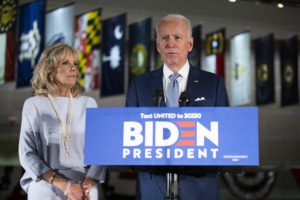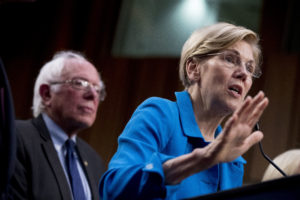‘Medicare for All’ Would Help Heal the Income Gap
The benefits of such a plan far outweigh the costs to the uppermost strata of American taxpayers. A 2017 Medicare for All rally in Los Angeles. (Molly Adams / Flickr)(CC BY 2.0)
A 2017 Medicare for All rally in Los Angeles. (Molly Adams / Flickr)(CC BY 2.0)
An overlooked aspect of the health care debate is how “Medicare for All” could reduce the income inequality that separates America’s rich from the poor and middle class.
In the presidential campaign, attention has been focused on well-publicized, important questions of patient care: Will I lose my company- or union-sponsored health insurance? Will I have my choice of a doctor or be forced to wait for care from a narrow network of health providers, making a visit to a physician as harrowing as a trip to the Department of Motor Vehicles? What about pre-existing conditions? Will rising deductibles and copays bedevil me? Will my family be able to afford medical care, or will a serious illness bankrupt us?
But beyond these questions is a broader issue, one that explains the difficulty of providing the nation with the health care it needs. Income inequality is the root cause of health care woes, and it is becoming more widespread. A family of five, with middle-income earnings of $53,000, is feeling the pressure of high health costs, as are low-income Americans making less money.
Health insurance premiums are rising faster than pay, the Kaiser Family Foundation reported in September. “Despite the nation’s strong economy and low unemployment, what employers and workers pay toward premiums continues to rise more than workers’ wages and inflation over time,” the foundation said. “The cost of private health insurance is out of control,” wrote Drew Altman, who heads the foundation. Meanwhile, a 2019 study by the UC Berkeley Labor Center noted, “Since 2008, premiums for job-based family health coverage have grown by 49 percent on average.”
These factors could add up to make health care the most decisive domestic issue of the 2020 election, possibly zooming to the top after cable news journalists, with their short attention spans, tire of impeachment and move on to something else.
The debate in the contest for the Democratic presidential nomination has revolved around two approaches. One is a Medicare for All type of plan, espoused by Sens. Bernie Sanders and Elizabeth Warren. Both favor a transitional period from the current Affordable Care Act (ACA) system. Many details remain unclear, but people would probably be enrolled at birth or when they immigrated and got resident status.
The other approach, generally supported by other candidates ranking high in the polls—among them former Vice President Joe Biden, ex-South Bend, Ind., Mayor Pete Buttigieg, Sen. Amy Klobuchar and businessman Andrew Yang—would keep Obamacare, with some adjustments. They propose retaining private insurance and adding a government insurance policy—the “public option”—to the current menu of private policies offered on the exchanges, or electronic marketplaces, that are one of the most important features of the ACA. Through the exchanges, consumers can buy a variety of plans from private insurance companies. Low- and middle-income consumers are eligible for tax credits—reductions in their income tax bills—to help them pay premiums. The public option would offer lower-cost policies. Competition from the government policies, advocates say, would drive down the price of private insurance.
Republicans just want to eliminate the whole thing. The Center on Budget and Policy Priorities predicted that the GOP’s favored route of “striking down the ACA … would cut taxes sharply for the highest-income Americans and certain corporations [amounting to] … a massive transfer of income from low- and moderate-income Americans to people on the top rungs of the income ladder.”
But the Republicans’ destructive ambition seems to have been thwarted by the growing approval of the ACA. Just look at the numbers: A total of 11.46 million have signed up for Obamacare through government-sponsored exchanges, reports Charles Gaba on his respected acasignups.net website. In addition, 74.8 million low-income people receive benefits from the federal/state Medicaid program, an enrollment boosted by provisions of the ACA.
Beyond the exchanges and Medicaid, the many provisions of the health care law have improved the lives of millions, including those who buy health insurance through employer- or company-sponsored plans or purchase policies individually. Those with pre-existing conditions, totaling 54 million, are now covered. Young people, through the age of 26, are now included in their parents’ plans. Maternity, outpatient, mental health, substance abuse and preventative care must now be included in health insurance plans. Low-income individuals and families, long denied care, now receive it through Medicaid. While reporting on this story over the past few years, I have seen how poor people, once denied care, now regularly visit physicians and dentists, living healthier lives because of Obamacare.
A huge factor that hangs in the balance is the fate of employer-sponsored group plans covering about 153 million people, as the Kaiser Family Foundation found. Many beneficiaries are happy with their coverage. I’ve talked to union members and others who receive benefits from their corporate employers, public universities and colleges, school systems and other institutions. They fear a new government scheme for health care wouldn’t be as good as what they have, even though the current version is flawed.
Yet there’s no guarantee that private employers would continue their plans. The same is true of unions, increasingly in danger of being busted, and of financially hard-pressed public universities and colleges and school systems.
Public opinion is divided, according to Kaiser Family Foundation polling. A total of 53% favor Medicare for All, while 43% oppose it. When informed that Medicare for All would eliminate private insurance, opponents rose to 58%, with those in favor dropping to just 37%. Most people included in that poll favored improving the ACA rather than replacing it with something new.
In the face of a divided public, the backers of Medicare for All make convincing arguments. “Here’s what is unbelievable,” Sanders told the Los Angeles Times editorial board late last month: “[S]ome half a million people go bankrupt in this country for medically related reasons. … [Y]ou’re struggling financially; you’re diagnosed with cancer. … You make $50,000 or $60,000 a year, you run up a bill for $50,000, $100,000. How do you pay that bill? I mean, it’s insane,” said the characteristically blunt Vermont senator. “So we are living in a country which says that you can suffer financial ruin for the rest of your life, for what crime did you commit? You were diagnosed with cancer or heart disease.”
Sanders is the father of the current drive for Medicare for All, having made it part of the national dialogue during his 2016 campaign for the presidency. Dr. Don McCanne, past president of Physicians for a National Health Program, has made a strong case that Medicare for All would begin closing the gap between rich and poor. “The purpose of government subsidies is to transfer payment for health care from the wealthy to those who cannot afford to pay for their full, evenly-divided allocation of our national health care bill,” he said. “That now includes middle-income America.”
UC Berkeley economists Emmanuel Saez and Gabriel Zucman explained in The Guardian in October how Medicare for All would improve the lives of underpaid workers. They cited the case of a secretary earning $50,000 and contributing $15,000 through her employer to an insurance company. “With universal health insurance,” Saez and Zucman wrote, “her wage would rise to $65,000—her full labor compensation. With an income tax of 6%—which, if applied to a base large enough, would be enough to fund universal health insurance—she would have to pay about $4,000 more in tax. But the net gain would be enormous: $11,000. Instead of taking home $50,000, the secretary would take home $61,000.”
The secretary’s life and that of her family would improve. If she contracted cancer or another debilitating ailment, she would not be bankrupted by the cost. She, her family and friends could devote their energy to her care. Moreover, she and her family would be assured of dental care. The cost of prescription drugs would drop.
Under either Sanders or Warren, Medicare for All would cost the wealthy more money. So would the lesser plans of the other Democratic candidates. But the end result is clear: These plans would help ease the income inequality that is blighting the country.
Your support matters…Independent journalism is under threat and overshadowed by heavily funded mainstream media.
You can help level the playing field. Become a member.
Your tax-deductible contribution keeps us digging beneath the headlines to give you thought-provoking, investigative reporting and analysis that unearths what's really happening- without compromise.
Give today to support our courageous, independent journalists.






You need to be a supporter to comment.
There are currently no responses to this article.
Be the first to respond.